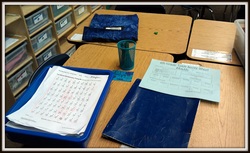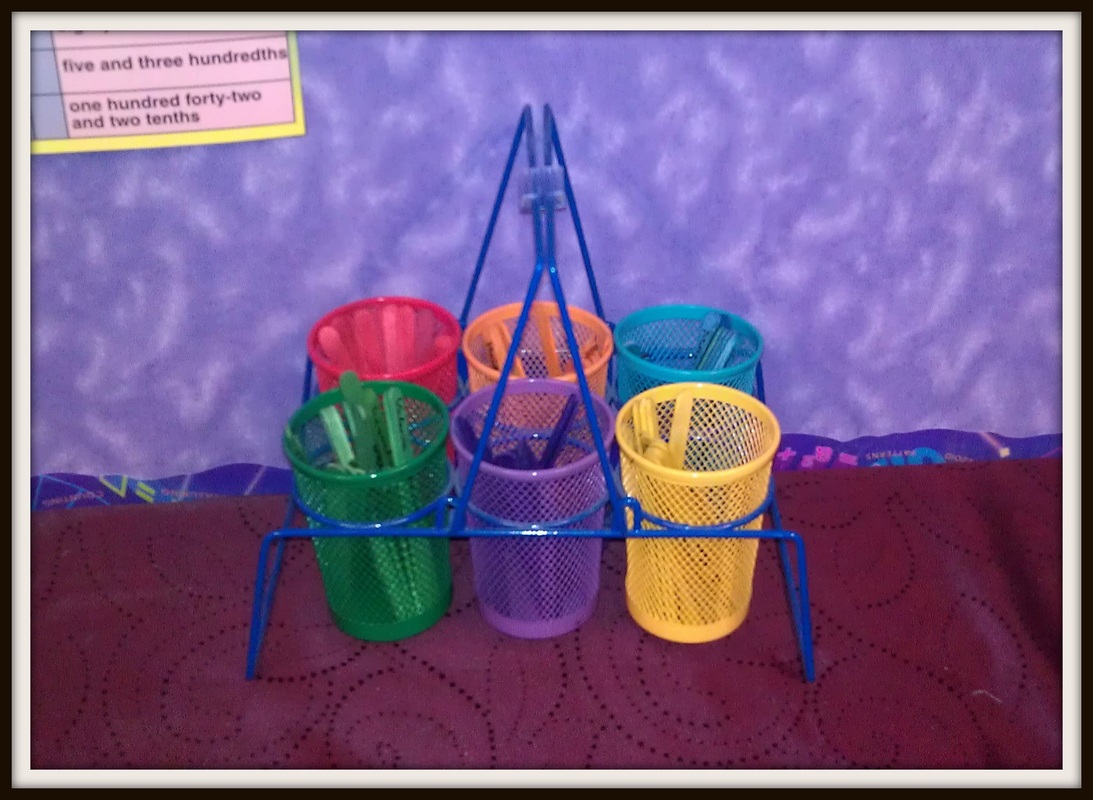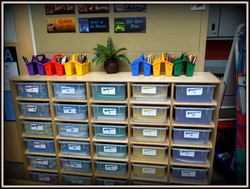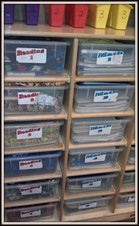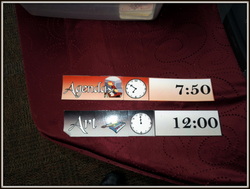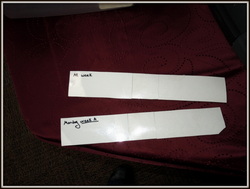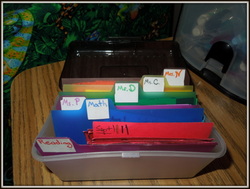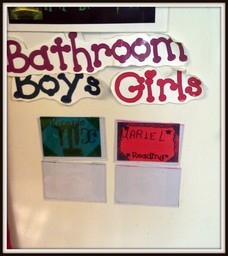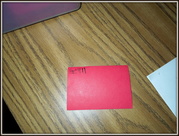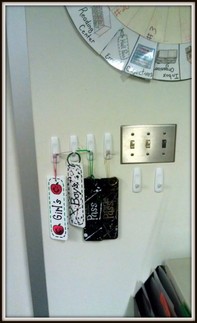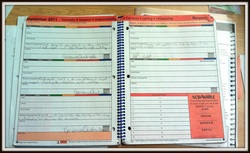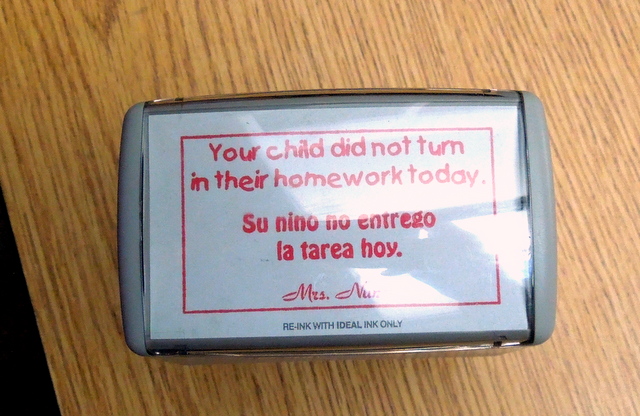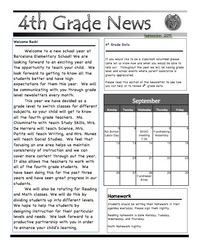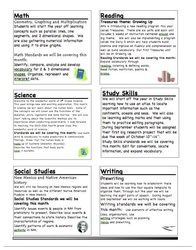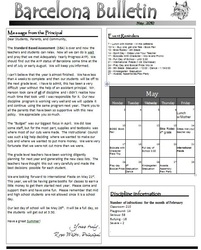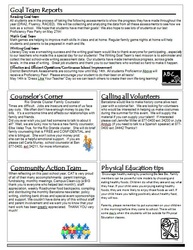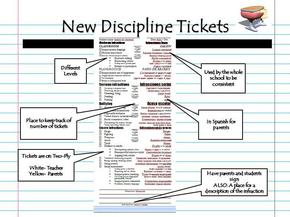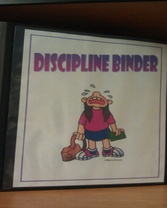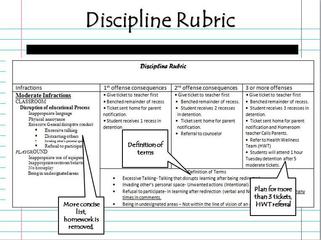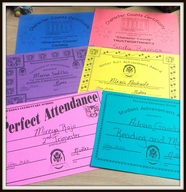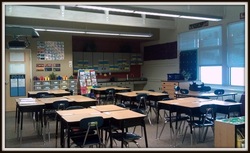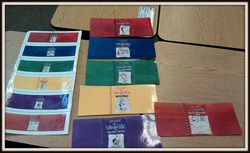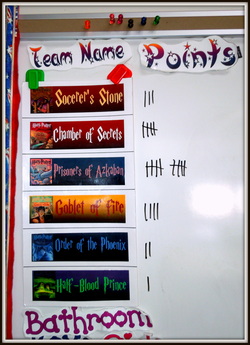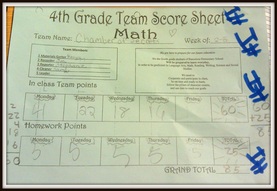Save Time Grading
Student order and numbers
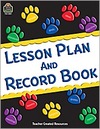
Gradebook
My Gradebook- I do my gradebook differently than most people; this is a perfect example of how I think out of the box… I organize my grade book by (wait for it) first names!! I know, I know; people always want to alphabetize by last names and I get more stressed out reactions when I tell people about this. The REASON I alphabetize by first name is that the students all know each other’s first name; so having them help me remain organized throughout the year is easier if I alphabetize by first name. Setting up my classroom this way allows me to develop systems that make my life easier. I have currently converted all of my gradebook over to Microsoft excel and Google Spreadsheets.
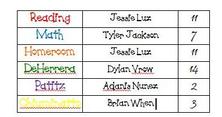
Desk nametags
Everything
starts with my gradebook. I don't like to carry around a grade book and
a lesson plan book, and a calendar. I found the best combination of all of them
in one lesson plan book (and the logo matches our mascot as well, nice perk.) At the beginning of the year I wait a week or
two, alphabetize my students by first name, and then write their names in order
in my gradebook. Every student has a number next to their name- I then assign
each student this number. I do this by writing the student’s number
next to their names on the student nametags that I tape on desks. Since
we rotate our classrooms, I do this for reading, math, and 4 different Social
Studies classes. I created a nametag that allowed me to do that.
I then make the students learn and remember their student number. If a new student comes later on in the year I just add them to the end. The first thing I do is make the students line up in order anytime we go somewhere. This has helped me during fire drills, on my way to specials, on field trips etc. I can quickly tell the student "line up" and within 2-3 minutes I know who is missing; and best of all THEY know who is missing. Once we had an accidental fire drill during recess and my students ran out to the field and lined up in order. I was one of the only teachers who wasn't panicking about where my students were.
I then make the students learn and remember their student number. If a new student comes later on in the year I just add them to the end. The first thing I do is make the students line up in order anytime we go somewhere. This has helped me during fire drills, on my way to specials, on field trips etc. I can quickly tell the student "line up" and within 2-3 minutes I know who is missing; and best of all THEY know who is missing. Once we had an accidental fire drill during recess and my students ran out to the field and lined up in order. I was one of the only teachers who wasn't panicking about where my students were.
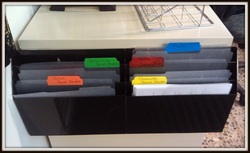
Inbox
The second way I use the student’s numbers is on tests. Students know when they write their names on their papers, they also need to write their student number in the top right corner. Students turn in their work to the inbox, which is already divided into 6 Sections 1: Reading class papers. Section 2: Math class papers. Sections 3,4,5,6- Social Studies class papers for each teacher (Ms. Patitz, Mrs. DeHerrera, Ms. Chiuminatto and Homeroom). At the end of the day one of my students has the job of "inbox organizer." That student takes all the papers in one folder, puts them in order by the student number, and then puts the folder into my teacher bag. Now all the pages are automatically alphabetized by first name, AND they are in the same order as my grade book.
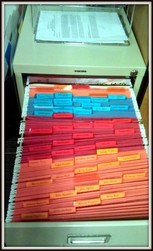
Student filing cabinet
I am able to grade the papers and then quickly enter them into my grade book. After I am done with my pile of graded papers 2 things can happen. #1 I hand the papers back to students for Student Data Binders or I file the papers to keep until parent teacher conferences. I keep all the papers in order still so another student, whose job is filer can take those pages and file them my small filing cabinet. Each different subject has color-coded hanging file folders (see below about color coding), each with the students name written on them once again in the same order- so the filer just has to go through the pile and quickly place papers into the correct hanging file.
I have learned over the years students are very quick and willing to make this system work if they are alphabetized by first names, when I did this by last names students were a lot more confused OR tried to use each other’s first names. So I figured why not just always use them. I also realized that grading papers took a lot less time them writing them in my lesson plan book, or handing the papers back out.
I have learned over the years students are very quick and willing to make this system work if they are alphabetized by first names, when I did this by last names students were a lot more confused OR tried to use each other’s first names. So I figured why not just always use them. I also realized that grading papers took a lot less time them writing them in my lesson plan book, or handing the papers back out.
Save Time Organizing
I love to have a classroom where items are easy to find and locate, that looks clutter-free and professional and that makes transitions quick. I realized about 3-4 years ago it was impossible for me to do this everyday. I would go through all the folders to make sure students papers were organized, or which books were missing, or putting folders away in the correct places. I decided to work smarter, instead of working harder. I created some systems that allowed me to save time to do "teacher" jobs, and I left the job of organizing and staying organized to my students
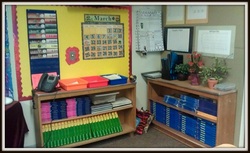
Area for student text books
I use cooperative learning groups in my classroom for all the different subject areas. This helps with language acquisition because my policy is never to ask a question the teams can't discuss first. Students can discuss the question and answers in their home language, but must work together as a team to phrase the response in English. In order to make materials more accessible to students I keep all student work in one corner of the room. Social Studies and Reading textbooks are kept in this location and only one student from each team (materials getter) is allowed to get the materials.
Student supplies

In addition to large team bins, students have individual cubbies they check at the end of the day. When they transition between classes they stick their homework folders in the correct student cubby so they can retrieve it before they go home at the end of the day. I also have a student job that is "postmaster" where I put all the piles of papers that need to be handed out to students such as book orders, roller-skate night information, curriculum night flyers etc.
Jobs
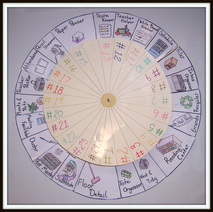
This brings me to the last way I stay organized and that is with my student jobs. Everyday students have 8 minutes to complete their jobs. I switch student teams once every 1-2 months, and when I switch they will receive a new job. I have a variety of jobs in my classroom and each job is removable, so I can replace it with something different if I have to. Some examples of student jobs are picking up the floor, organizing totes, putting books away in the reading center, running errands, organizing papers in the inbox, filing student work, unhooking the electronic whiteboard, passing out papers, sharpening pencils, taking the attendance to the office, putting papers in student cubbies etc.
Save Time Instructing
Schedule
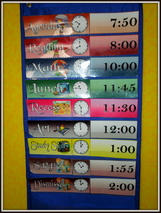
One of the simplest ways I have for saving instructional time is to have a daily schedule. Since I teach 4th grade students they are in charge of maintaining it. I had seen different schedules to buy but they always had something lacking. Like I said before I like to color code everything and I couldn't find a schedule that was color-coded. A lot of the schedules didn't have icons; which I think are important for my English language learners, and they also didn't have an analog clock. Some schedules came close but you had to constantly write-in the times with a dry erase marker which constantly rubbed off. I decided to create my own schedule on the computer.
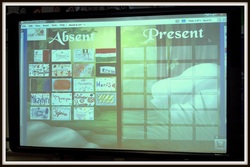
I also have the students come into the classroom and move their name from absent to present so I can take attendance quickly. The students created names at the beginning of the year that were scanned into the computer and added to the promethean board. It is easy to add in a new student when one comes. Student names are in order again on the board, so after they have their agendas checked quickly in line, they come into the classroom in the same order and move their names; then hang up their backpacks.
Parent Communication
In edition to the agendas being sent home nightly, parents have two monthly communications sent home, one pertaining to the grade level and another pertaining to the entire school. Since the 4th grade team collaborates so closely, the 4th grade newsletter has sections that are written by each teacher and compiled into one document. The school-wide newsletter is comprised of information from each goal team as well as a message from the principal. I gather all the "blurbs" together to create a monthly parent bulletin.
Save time redirecting misbehavior
Class Rules
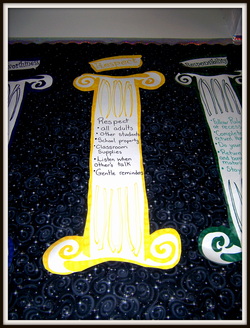
All the classroom rules for the year are put under the different categories of character counts. At the beginning of the year we discuss all the different pillars of character counts and what that looks like. Then as a class we make a list for each one- Trustworthiness, respect, responsibility, fairness, caring, citizenship. That list is later developed into a list of rules for each pillar. I usually go out of my way to match the list to what I already have written on the pillars- every year students come up with the same thing.
Then we spend time in teams acting out what that looks like, and what that doesn't look like. We practice and reinforce that. The whole first 2-3 weeks of school I will stop the entire class if someone is misbehaving and remind them "someone in this class is not being a good citizen. In your teams discuss what being a good citizen looks like, and let's practice."
After the 2 weeks most students know what is expected. If a student still forgets I will pull them aside and have a conversation about which pillar the student is not following. If the student continues after the warning the student will receive a discipline ticket.
Then we spend time in teams acting out what that looks like, and what that doesn't look like. We practice and reinforce that. The whole first 2-3 weeks of school I will stop the entire class if someone is misbehaving and remind them "someone in this class is not being a good citizen. In your teams discuss what being a good citizen looks like, and let's practice."
After the 2 weeks most students know what is expected. If a student still forgets I will pull them aside and have a conversation about which pillar the student is not following. If the student continues after the warning the student will receive a discipline ticket.
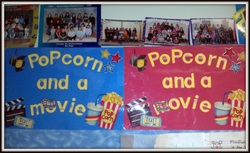
As an entire class if each team get more than 25 points each in one day, the students are a "cooperative learning class," which is what we want everyday. When this happens the students earn a letter on the Popcorn and a Movie sign. I move the little film strip to a letter each time and when the class completely spells out popcorn and a movie, the entire class gets to vote on a movie and I bring popcorn and we watch the movie.
